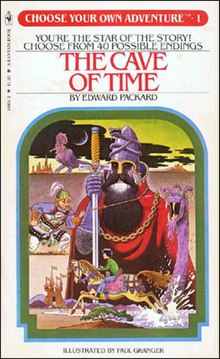Choose Your Own Adventure

The Cave of Time by Edward Packard, the first book in the series
|
|
| Cover artist | Paul Granger |
|---|---|
| Language | English |
| Genre | Gamebook |
| Publisher | Bantam Books |
| Published | 1979–1998 (original series) |
| Media type | |
| No. of books | 184 (original series) (List of books) |
Choose Your Own Adventure is a series of children's gamebooks where each story is written from a second-person point of view, with the reader assuming the role of the protagonist and making choices that determine the main character's actions and the plot's outcome. The series was based upon a concept created by Edward Packard and originally published by Constance Cappel's and R. A. Montgomery's Vermont Crossroads Press as the "Adventures of You" series, starting with Packard's Sugarcane Island in 1976.
Choose Your Own Adventure, as published by Bantam Books, was one of the most popular children's series during the 1980s and 1990s, selling more than 250 million copies between 1979 and 1998. When Bantam, now owned by Random House, allowed the Choose Your Own Adventure trademark to lapse, the series was relaunched by Chooseco, which now owns the CYOA trademark. Notably, Chooseco does not reissue titles by Packard, who has started his own imprint, U-Ventures.
Originally created for 7- to 14-year-olds, the books are written in the second person. The protagonist—that is, the reader—takes on a role relevant to the adventure; for example, private investigator, mountain climber, race car driver, doctor, or spy. Stories are generally gender and race neutral, though in some cases, particularly in illustrations, presumption of a male reader (the target demographic group) do appear. In some stories, the protagonist is implied to be a child, whereas in other stories, he/she is presumably a young adult.
The stories are formatted so that, after a couple of pages of reading, the protagonist faces two or three options, each of which leads to more options, and then to one of many endings. The number of endings is not set, and varies from as many as 44 in the early titles, to as few as 8 in later adventures. Likewise, there is no clear pattern among the various titles regarding the number of pages per ending, the ratio of good to bad endings, or the reader's progression backwards and forwards through the pages of the book. This allows for a realistic sense of unpredictability, and leads to the possibility of repeat readings, which is one of the distinguishing features of the books.
As the series progressed, both Packard and Montgomery experimented with the gamebook format, sometimes introducing unexpected twists such as endless page loops or trick endings. Examples include the "paradise planet" ending in Inside UFO 54-40, which can only be reached by cheating or turning to the wrong page by accident, and the potentially endless storyline in Race Forever.
...
Wikipedia
